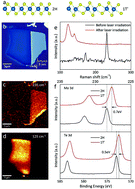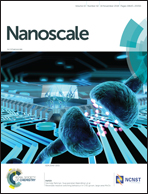Controllable 2H-to-1T′ phase transition in few-layer MoTe2†
Abstract
Most two-dimensional (2D) transition metal dichalcogenides (TMDs) exhibit more than one structural phase, leading to a number of remarkable physics and potential device applications beyond graphene. Here, we demonstrated a feasible route to trigger 2H-to-1T′ phase transition in few-layer molybdenum ditelluride (MoTe2) by laser irradiation. The effects of laser power and irradiation duration were systematically studied in this study, revealing the accumulated heating effect as the main driving force for such a phase transition. By carefully adjusting laser power and irradiation time, we could control the structural phases of MoTe2 as 2H, 2H + 1T′, and 1T′. After thermal annealing at a rather low temperature, the laser-irradiated MoTe2 showed a completely suppressed 2H component and a more stabilized 1T′ phase, demonstrating that the microscopic origin of the irreversible 2H-to-1T′ phase transition is the formation of Te vacancies in MoTe2 due to laser local instantaneous heating. Our findings together with the unique properties of MoTe2 pave the way for high-performance nanoelectronics and optoelectronics based on 2D TMDs and their heterostructures.



 Please wait while we load your content...
Please wait while we load your content...